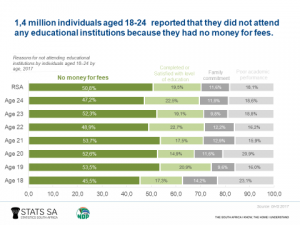More than half of youth have no money to pay for their tuition
More than half (or 51%) of youth aged 18–24 claimed that they did not have the financial means to pay for their tuition. Furthermore, 18% of those aged 18–24 who were not attending educational institutions indicated that their poor academic performance prevented them from participating. This is according to the “Higher Education and Skills in South Africa” report released by Statistics South Africa
The report, which uses data from the General Household Survey (GHS) 2017, indicates that only 33,8% of youth aged 18–24 were attending educational institutions. Among those, 22,2% were attending school while 11,6% were attending post-school educational institutions.
In 2017, only three-quarters of male students who attended Grade 10 in 2016 progressed to Grade 11, while the same was true for close to 87% of female learners. During the same period, even fewer males (71%) who attended Grade 11 in 2016 progressed to Grade 12 the following year, while 76% of the females did the same.
The report shows that the general trend in participation in all institutions of post-school learning was upward, with total enrolment in higher education institutions in 2016 amounting to 49,9% of all enrolments within the sector; TVET colleges amounted to 30,8% of all enrolments; CET colleges 11,9% of all enrolments; and private colleges 7,4% of all enrolments within the sector.
Despite gains in higher education participation rates, gender disparity was still a challenge, as was participation equity for students from low-income backgrounds. Female participation in 2016 at public higher educational institutions (universities) was 58%, and 57% at TVET colleges. Most students were enrolled in undergraduate NQF Level 7 programmes at universities, mostly studying for qualifications in the fields of business, commerce and management sciences, education or engineering. Most students enrolled at TVET colleges in 2016 were studying for Report 191 qualifications. NATED / Report 191 programmes are delivered under the auspices of the Department of Higher Education and Training and quality assured by Umalusi. The programmes consist of 18 months of theoretical studies at colleges and 18 months relevant practical application in work places. Engineering studies range from N1 – N6 while Business and Utility Studies range from N4 – N6.
According to the report, the number of graduates from public higher universities more than doubled from 92 874 in 2000 to 203 076 in 2016. In 2016, the number of graduates from TVET and private colleges stood at 135 492.
The time taken by students to complete their undergraduate qualifications also improved over time. However, the higher education system still has challenges in terms of their success rates and poor completion rates. Many students drop out without completing a qualification, or they take up to six years to complete a three-year qualification. Very few students progress to advanced NQF levels of study (NQF levels 8–10). Honours (19,8%), masters (6,3%) and doctoral studies (1,4%) accounted for a relatively small percentage of the overall tertiary qualifications awarded in 2016.
According to the report, close to 47% of youth aged 20–24 years who held bachelor degrees or qualifications equivalent to NQF Level 7 came from the highest household income quintile. In comparison, only 7,4% of youth who held qualifications equivalent to NQF Level 7 came from the lowest household income quintile. Furthermore, close to 36% of youth holding postgraduate degrees or qualifications equivalent to NQF Levels 8–10 came from the highest household income quintile.
For more information, download the “Higher Education and Skills in South Africa” report here.


